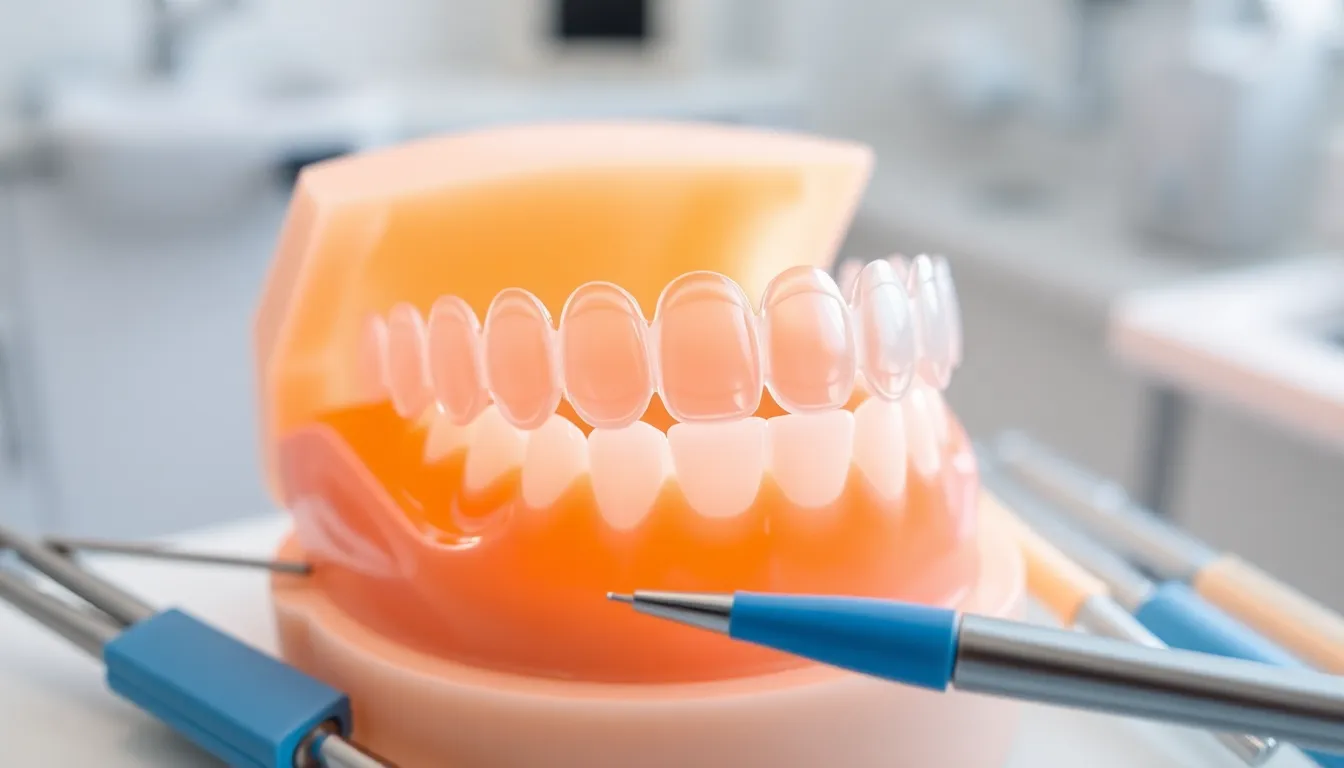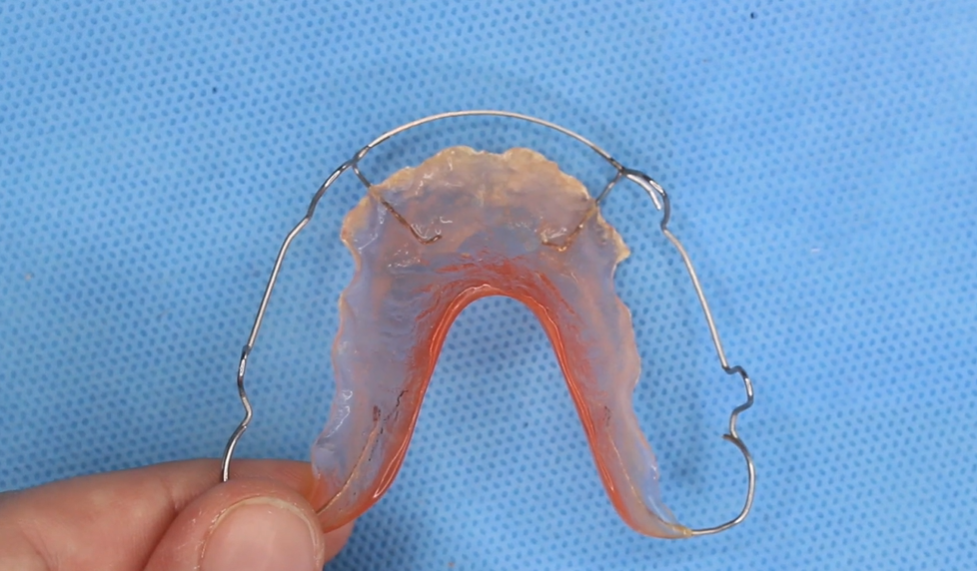If you buy through links on our site, we may earn a small affiliate commission to help support the blog - at no extra cost to you. It never influences our product selection process. Thank you!
Have you noticed a gap between your Invisalign tray and teeth? This common issue can leave you wondering if your treatment is working properly or if something’s wrong with your aligners.
When Invisalign trays don’t fit snugly against your teeth, it might indicate a tracking problem that could affect your treatment timeline. These spaces—sometimes called “halos”—appear as visible gaps where the aligner lifts away from your tooth surface. Understanding why these gaps occur and how to address them is crucial for keeping your orthodontic treatment on track and achieving the smile transformation you’re investing in.
Understanding Invisalign and Common Fit Issues
Invisalign clear aligners have revolutionized orthodontic treatment by offering a discreet alternative to traditional braces. These custom-made, transparent trays gradually shift teeth into their desired positions through a series of progressive alignments. Many patients choose Invisalign for its aesthetic appeal and convenience, but proper fit is crucial for treatment success.
How Invisalign Should Properly Fit
Properly fitted Invisalign trays sit snugly against your teeth with minimal space between the aligner and tooth surface. When correctly positioned, the aligners apply precise pressure to exact teeth, guiding them toward their planned positions. Dr. Todd B. Harris explains, “A well-fitting Invisalign tray feels secure but not painful. You’ll notice it’s snug all around your teeth, with the edges resting comfortably along your gumline.”
Ideally, you shouldn’t see important gaps or spaces between the aligner and your teeth. The tray edges should align evenly with your gumline without digging in or standing away from the tissue. Your bite might feel slightly different when wearing the aligners, which is normal as they work to adjust your teeth alignment.
Common Fit Problems with Invisalign
Several fit issues can occur during Invisalign treatment:
- Halos – Visible gaps between the aligner and teeth, appearing as clear rings or spaces
- Edge discomfort – Sharp or rough tray edges that irritate gums or cheeks
- Excessive tightness – Aligners that cause important pain rather than mild pressure
- Loose fit – Trays that feel wobbly or easily dislodge when speaking or eating
- Partial seating – Aligners that fit some teeth perfectly while leaving gaps around others
Lisa, one of Dr. Harris’s patients, recalled her experience: “I noticed a small gap between my new tray and my front teeth. I thought it would resolve on its own, but after showing Dr. Harris, he explained this was a tracking issue that needed immediate attention to prevent treatment delays.”
The most concerning fit problem—gaps between the aligner and teeth—often indicates tracking issues. Tracking refers to how well your teeth are following the predetermined treatment path. Poor tracking causes teeth to fall behind schedule, creating spaces between the aligner and tooth surfaces that can compromise your treatment results.
The Impact of Poor Fit on Treatment
A poor Invisalign fit extends beyond discomfort and affects treatment efficacy in multiple ways:
- Extended treatment timeline – Teeth moving off-track often require correction and additional aligners
- Inconsistent results – Some teeth may shift correctly while others lag behind
- Increased discomfort – Improperly fitted aligners can cause uneven pressure and pain
- Additional costs – Correcting fit issues may require refinement aligners at extra expense
Dr. Harris emphasizes, “Early identification of fit problems saves time and frustration. Many patients don’t realize that a small gap can signal a important issue until their treatment stalls. Regular check-ins help us catch and address these problems before they derail your progress.”
Understanding these common fit issues helps you recognize potential problems early and seek appropriate intervention from your orthodontist, keeping your Invisalign treatment on track for optimal results.
Why Gaps Form Between Invisalign Trays and Teeth

Gaps between Invisalign trays and teeth (often called “halos”) occur when aligners don’t fit perfectly against tooth surfaces. These spaces can significantly impact treatment effectiveness and slow down your progress toward your ideal smile. Let’s explore the most common causes of these troublesome gaps.
Material Warping and Damage
Invisalign trays can warp or become damaged through everyday handling mistakes. Removing aligners incorrectly—by pulling from one side instead of evenly—creates stress points that distort the plastic over time. Even subtle warping prevents the trays from fitting snugly against your teeth, creating noticeable gaps between the aligner and tooth surface. Structural damage like cracks compromises the tray’s ability to apply consistent pressure, reducing its effectiveness in moving teeth according to your treatment plan.
“I had a patient who stored her aligners wrapped in a napkin during meals,” recalls Dr. Todd B. Harris. “She accidentally threw them away twice, and when she retrieved them, they were slightly warped from being crushed. Those barely visible changes in shape created tracking problems we had to address with replacement trays.”
Improper Seating Technique
Not fully seating your aligners ranks as one of the most common causes of gaps. Failing to wear your trays for the recommended 22 hours daily disrupts the continuous pressure needed for tooth movement. Many patients don’t properly push aligners onto their teeth, especially in hard-to-reach areas at the back of the mouth. This incomplete seating creates a poor tracking situation where teeth aren’t moving as planned, resulting in visible gaps between the tray and teeth.
Advancing to the next tray too early—before your current tray fits perfectly—compounds this problem. Your teeth need sufficient time to shift into their planned positions before moving to the next stage. Rushing this process creates misalignment between your actual tooth position and what the next tray expects, causing noticeable gaps that worsen with each premature advancement.
Tracking Problems
Teeth sometimes move at different rates or directions than predicted by your treatment plan. Some teeth prove stubborn and resist movement, while others shift faster than expected. These variations create situations where certain teeth don’t track properly with your aligners. Tooth collisions during movement also create fitting issues, especially in crowded areas where teeth compete for space.
Your orthodontist might perform interproximal reduction (IPR)—a procedure that creates tiny spaces between crowded teeth—to address these tracking problems. Also, the initial digital models used to create your aligners can’t perfectly predict how your unique dental structure will respond to treatment. These biological variations sometimes necessitate mid-treatment refinements to get your progress back on track.
How to Recognize When Gaps Are a Problem

Detecting when gaps between your Invisalign trays and teeth become problematic requires knowing what to look for during your treatment journey. Not all spaces indicate issues, but certain signs clearly point to treatment complications that need addressing.
Normal Small Gaps vs. Concerning Spaces
Minor spaces between your aligner edge and teeth are completely normal during Invisalign treatment. These small gaps allow for comfortable wear without causing painful constriction of your gum tissue. Typically, these normal gaps measure less than 1mm and appear as slight clearance at certain points along the aligner edge.
Concerning spaces, but, measure between 1 to 4mm or larger and signal a tracking problem. These important gaps reduce the necessary pressure on your teeth, effectively stalling your treatment progress. One of our patients, Sarah, noticed a 2mm gap forming around her upper canines after returning from vacation. Upon examination, we discovered she’d been removing her aligners more frequently for meals and social events, reducing her daily wear time to about 18 hours instead of the recommended 22 hours.
Signs Your Treatment May Be Off Track
Several clear indicators suggest your Invisalign treatment isn’t progressing as planned. Visible “halos” (air gaps) between the aligner and teeth surfaces represent the most obvious sign of tracking issues. Your aligners should feel secure rather than loose when properly seated, with a distinct snap when placed correctly.
Unexpected spaces developing between teeth that were previously closed indicate movement regression. Aligners sitting noticeably higher on teeth than previous trays point to incomplete tooth movement from the prior stage. Persistent discomfort beyond the initial adjustment period often signals improper fit.
Dr. Harris notes, “The relationship between aligner fit and treatment success is direct. When patients report gaps developing mid-treatment, we immediately check compliance patterns, as inconsistent wear accounts for approximately 80% of tracking problems we see in our practice.”
Common causes of these concerning gaps include wearing aligners less than 22 hours daily, advancing to the next tray prematurely, manufacturing variations in the custom aligners, and natural variations in tooth movement response. Each of these factors disrupts the precisely calculated pressure sequence needed for successful tooth movement.
If you identify important gaps, contact your orthodontist promptly rather than waiting until your next scheduled appointment. This proactive approach can prevent weeks of ineffective treatment and keep your smile transformation on schedule.
Solutions for Invisalign Tray Gaps

Addressing gaps between your Invisalign trays and teeth requires exact techniques and consistent habits to ensure effective treatment progress. These practical answers can help improve aligner fit and keep your orthodontic treatment on track.
Using Chewies and Aligner Seaters
Invisalign Chewies serve as essential tools for improving aligner fit and eliminating gaps between trays and teeth. These small, cylindrical foam devices help seat your aligners properly when you bite down on them for 10-15 seconds per area. Many patients find that using Chewies several times daily, especially after inserting a new tray, significantly improves tracking and reduces visible gaps. Aligner seaters work similarly but come in different shapes that some patients find more comfortable or effective. Dr. Todd B. Harris often recommends incorporating Chewies into your daily routine, noting that “patients who consistently use Chewies typically experience better tracking and fewer complications during their Invisalign treatment.”
Consistent Wear Time and Proper Handling
Maintaining the recommended 22 hours of daily wear time directly impacts how well your aligners fit. Removing your trays for more than the allotted 2 hours per day reduces the continuous pressure needed for proper tooth movement. Many tracking issues resolve simply by increasing wear time and following a strict schedule. One patient shared, “After noticing gaps forming, I committed to wearing my aligners for the full 22 hours daily, and within a week, the gaps disappeared and my treatment got back on track.”
Proper Aligner Insertion and Removal
The technique you use to insert and remove your aligners can significantly affect their fit. Always insert aligners using fingertip pressure starting from the molars and working forward. Remove them by gently loosening from the back teeth on both sides simultaneously rather than pulling from one point. Incorrect handling contributes to aligner warping, which creates persistent gaps between the tray and teeth.
Preventing Gaps Between Invisalign and Teeth

Keeping your Invisalign treatment on track requires proactive measures to prevent gaps between your aligners and teeth. Consistent habits and proper techniques significantly reduce the likelihood of developing these troublesome spaces that can delay your progress toward a perfect smile.
Proper Aligner Care and Handling
Maintaining clean, undamaged aligners ensures they fit snugly against your teeth without creating gaps. Rinse your trays with lukewarm water whenever you remove them to prevent buildup of bacteria and saliva proteins that can affect their shape. Daily cleaning with Invisalign cleaning crystals or a gentle, clear antibacterial soap preserves the integrity of your aligners and promotes proper fit.
Invisalign Chewies are essential tools for eliminating air gaps between your trays and teeth. These small, cylindrical foam accessories help seat your aligners properly when you bite down on them for about 10-15 seconds per section of your mouth. Dr. Todd B. Harris often shares that “patients who use Chewies consistently report fewer fitting issues and stay on track with their treatment timeline.”
Avoid exposing your aligners to hot water or leaving them in direct sunlight, as temperature fluctuations can warp the plastic material. Store your trays in their protective case when not in use to prevent damage that might create fitting issues.
Wearing Your Aligners for the Recommended Time
Consistent wear for 20-22 hours daily creates the steady pressure needed for proper tooth movement. Removing your aligners for more than the recommended 2-4 hours prevents them from exerting the necessary force to shift your teeth according to your treatment plan. This inconsistent pressure often leads to tracking problems and visible gaps between your trays and teeth.
One patient, Sarah, discovered this firsthand: “I got into the habit of removing my aligners whenever I had coffee or snacks throughout the day. Soon I noticed gaps forming, and my orthodontist explained I wasn’t meeting the minimum wear time. After recommitting to the 22-hour schedule, the gaps disappeared within two weeks.”
Develop a routine that accommodates meals and oral hygiene while maximizing wear time. Tracking your daily wear with a mobile app or journal helps ensure you’re meeting the requirements. Regular check-ins with your orthodontist provide opportunities to address any developing gaps before they impact your treatment timeline.
Remember to transition between trays as directed by your orthodontist, typically every 1-2 weeks. Moving to new aligners too early or too late disrupts the carefully calculated progression of tooth movement and creates fitting issues. Following your prescribed schedule maintains proper alignment pressure and prevents gaps from forming between your Invisalign trays and teeth.
Conclusion
Addressing gaps between your Invisalign trays and teeth is crucial for successful treatment outcomes. When you notice halos forming remember they’re not just cosmetic concerns but potential signals that your treatment might be veering off course.
By using Chewies consistently maintaining the full 22-hour wear time and handling your aligners properly you can minimize gaps and keep your treatment on track. Don’t hesitate to contact your orthodontist if you notice persistent or growing gaps between your aligners and teeth.
With proactive management and regular professional oversight you’ll navigate through any fitting challenges and achieve the beautiful aligned smile you’re working toward with minimal delays or complications.
Frequently Asked Questions
What are Invisalign “halos” and why do they matter?
Invisalign “halos” are gaps between your aligners and teeth. They matter because they can indicate tracking problems where your teeth aren’t moving as planned. Small gaps (under 1mm) are usually normal, especially with new trays. However, larger gaps (1-4mm+) suggest your treatment may be off track, potentially extending your treatment timeline and affecting your final results.
How should properly fitted Invisalign trays feel?
Properly fitted Invisalign trays should sit snugly against your teeth with minimal visible gaps. You should feel gentle pressure, especially during the first few days of a new tray, but never intense pain. The aligners should fully cover your teeth and feel secure when in place. If you notice significant gaps or discomfort, contact your orthodontist for an evaluation.
What causes gaps between Invisalign trays and teeth?
Gaps between Invisalign trays and teeth typically result from three main causes: material warping/damage from improper handling or exposure to heat, incorrect seating technique when inserting aligners, and tracking problems where teeth aren’t moving as planned. Other factors include insufficient wear time (less than 22 hours daily) or advancing to new trays too early before teeth have fully shifted.
How can I tell if my Invisalign treatment is off track?
Your Invisalign treatment may be off track if you notice persistent gaps larger than 1mm between trays and teeth, unexpected spaces between previously closed teeth, or aligners that don’t seat properly despite using chewies. You might also experience unusual discomfort or find that your teeth don’t match the projected progress in your treatment plan. Contact your orthodontist if you observe these signs.
What are Invisalign Chewies and how do they help?
Invisalign Chewies are small, cylindrical foam accessories that help seat your aligners properly. By gently biting down on a Chewie for a few minutes several times daily, you create pressure that pushes your aligners into optimal position, particularly around problem areas. This helps close gaps between trays and teeth, improves tracking, and enhances the effectiveness of your treatment.
How many hours per day should I wear my Invisalign aligners?
You should wear your Invisalign aligners for 20-22 hours daily, removing them only for eating, drinking anything besides water, and oral hygiene routines. Consistent wear time is crucial for successful treatment. Insufficient wear time is a leading cause of tracking problems and gaps between aligners and teeth, potentially extending your overall treatment timeline.
What should I do if I notice gaps between my aligners and teeth?
If you notice small gaps with new aligners, use Chewies regularly to improve seating. For persistent or larger gaps, contact your orthodontist promptly. Don’t advance to the next tray if current ones aren’t fitting properly. Continue wearing your current tray for the recommended time and ensure you’re maintaining proper wear habits. Never force ill-fitting aligners as this can damage them.
How can I prevent my Invisalign trays from warping?
Prevent Invisalign tray warping by removing them properly (from the back molars first, then working forward), storing them in their case when not in use, avoiding hot water for cleaning, and keeping them away from heat sources and direct sunlight. Clean them gently with a soft toothbrush and appropriate cleaning solution, not toothpaste which can be abrasive.






